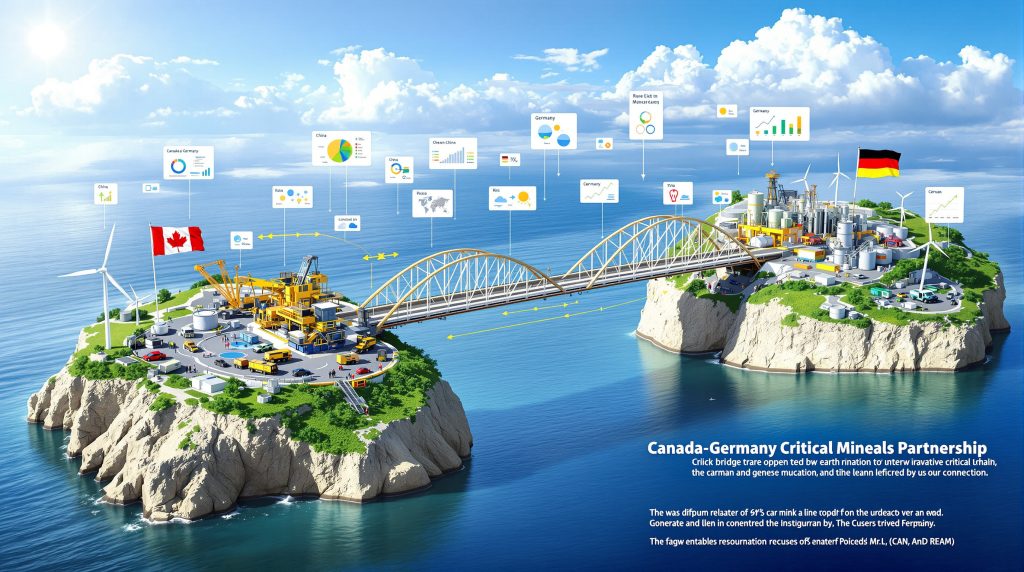Canada-Germany Critical Minerals Partnership: Building Secure Supply Chains for the Future
The strategic relationship between Canada and Germany has entered a new phase with the formation of a critical minerals partnership. This collaborative framework focuses on developing sustainable supply chains for essential resources including lithium, rare earth elements, copper, tungsten, gallium, germanium, and nickel. While non-binding in nature, the agreement establishes a foundation for deeper cooperation that promises to strengthen both nations' industrial capabilities while reducing dependence on dominant suppliers.
Core Partnership Elements
The partnership prioritizes several strategic objectives:
- Developing secure supply chains for minerals essential to clean energy technologies
- Enhancing midstream processing capabilities across the value chain
- Establishing direct commercial relationships between Canadian producers and German manufacturers
- Implementing rigorous environmental and social governance standards
- Supporting collaborative research initiatives for sustainable mining technologies
The agreement represents a significant step toward resource security in an increasingly competitive global landscape.
Geopolitical Context Driving the Alliance
Supply Chain Vulnerabilities Exposed
Recent global events have highlighted critical vulnerabilities in mineral supply chains that both Canada and Germany seek to address. China currently controls approximately 80% of global rare earth element processing capacity, creating significant dependencies for Western nations. This dominance extends to other critical minerals energy transition resources, with Chinese firms controlling roughly:
- 60% of global germanium production
- Significant portions of tungsten processing capabilities
- Substantial gallium refining capacity
Recent export restrictions by major producers have underscored these vulnerabilities, particularly affecting materials essential for defense systems, renewable energy technologies, and advanced electronics.
European Energy Security Concerns
Germany's experience with energy supply disruptions following Russia's 2022 invasion of Ukraine has profoundly shaped Berlin's approach to resource security. The sudden curtailment of Russian natural gas supplies forced Germany to rapidly restructure its energy procurement strategies, creating powerful incentives to avoid similar vulnerabilities in critical mineral supply chains.
This experience has accelerated Germany's efforts to diversify suppliers across all essential resource categories, with minerals required for clean energy transition receiving particular focus.
Accelerating Demand for Critical Resources
The International Energy Agency projects demand for minerals essential to clean energy technologies will increase 3-7 times by 2030, creating unprecedented pressure on global supply chains. This surge is driven by:
- Rapid electric vehicle manufacturing expansion
- Wind and solar deployment at unprecedented scales
- Battery storage system proliferation
- Growing hydrogen production infrastructure
- Advanced computing requirements for artificial intelligence
This demand trajectory creates both urgency and opportunity for the Canada-Germany critical minerals partnership.
Transforming Traditional Supply Relationships
Beyond Raw Material Exports
The partnership aims to fundamentally transform Canada's traditional position as primarily a raw material exporter. By developing domestic processing capabilities and moving up the value chain, Canadian producers can:
- Capture greater economic value from mineral resources
- Reduce transportation costs and emissions associated with shipping unprocessed materials
- Strengthen supply chain resilience through vertical integration
- Create high-skilled employment opportunities in processing facilities
For German manufacturers, these developments promise more reliable access to processed materials that meet rigorous environmental and governance standards.
Building Commercial Frameworks
Several commercial relationships are taking shape within the partnership framework. These include potential supply agreements between Canadian producers and German manufacturers across multiple critical mineral categories. Such agreements typically involve:
- Long-term offtake arrangements for processed materials
- Technical collaboration on material specifications
- Joint investments in processing capabilities
- Shared commitments to environmental standards
Industry analysts note that securing such arrangements provides crucial financial certainty for mining projects that often require 5-10 years from discovery to production.
Coordinated Governance Structures
To implement the partnership effectively, both nations have established coordinating mechanisms involving relevant ministries and industry stakeholders. These coordination efforts focus on:
- Aligning regulatory approaches to resource development
- Harmonizing technical standards and certification processes
- Developing shared financing models for critical infrastructure
- Coordinating research priorities and funding mechanisms
These governance structures provide essential foundations for translating high-level agreements into concrete commercial relationships.
Infrastructure Development Supporting Mineral Flows
Strategic Transportation Networks
Effective critical mineral supply chains require sophisticated transportation infrastructure. Canada's strategic location offers potential advantages for exports to European markets, particularly through:
- Atlantic shipping routes from eastern Canadian ports
- Seasonal northern shipping corridors via Arctic waters
- Integrated rail and port facilities optimized for mineral shipments
Potential infrastructure developments to support these supply chains include upgrades to existing port facilities and transportation corridors specifically designed for mineral shipments.
Energy Export Infrastructure
The partnership extends beyond minerals to encompass broader energy cooperation, including:
- Natural gas export capabilities aligned with European energy transition needs
- Hydrogen production infrastructure supporting industrial decarbonization
- Renewable energy investments supporting mineral processing
These energy components complement the mineral focus while addressing broader economic and climate objectives.
Financing Approaches
The partnership framework leverages multiple financing mechanisms to support necessary infrastructure development:
- Public investment through national infrastructure programs
- Development bank financing for projects meeting sustainability criteria
- Private capital mobilization through risk-sharing arrangements
- Blended finance approaches combining public and private resources
These financing tools help address the substantial capital requirements for developing modern mining and processing infrastructure.
Environmental and Social Governance Standards
Sustainable Mining Practices
The partnership places significant emphasis on environmental performance throughout the mineral supply chain:
- Energy-efficient extraction and processing technologies
- Water conservation and management systems
- Land reclamation and biodiversity protection measures
- Greenhouse gas emission reduction strategies
These environmental commitments aim to establish Canadian-German supply chains as global sustainability leaders.
Indigenous Rights and Community Engagement
A distinctive feature of Canadian resource development involves meaningful engagement with Indigenous communities. The partnership framework recognizes:
- The importance of respecting Indigenous rights in mining regions
- The value of traditional knowledge in environmental management
- The benefits of shared economic participation through equity ownership
- The necessity of community consent for project development
This approach aligns with international best practices while providing distinctive advantages for Canadian resource projects.
Regulatory Coordination
The partnership includes provisions for policy coordination on:
- Environmental impact assessment methodologies
- Material traceability and chain of custody documentation
- Permitting processes for resource development
- Standardized classification using the United Nations Framework Classification for Resources
This regulatory alignment helps reduce compliance complexity while maintaining high standards.
Broader Strategic Implications
NATO Alliance Strengthening
The partnership reinforces security cooperation between NATO allies, recognizing critical minerals as essential inputs for:
- Advanced defense systems requiring specialized materials
- Secure communications infrastructure
- Energy security underpinning military readiness
- Industrial capacity supporting defense production
These security dimensions highlight the strategic importance of critical mineral access beyond purely economic considerations.
International Coordination
The Canada-Germany critical minerals partnership exists within a broader context of international coordination on critical mineral security. This includes:
- G7 initiatives on supply chain resilience
- Multilateral research cooperation on sustainable extraction
- Information sharing on resource assessments and development
- Coordinated responses to supply disruptions
These multilateral efforts complement bilateral arrangements while addressing global challenges.
Values-Based Supply Chain Development
The partnership explicitly frames cooperation in terms of shared democratic values, emphasizing:
- Transparency in resource governance
- Fair labor practices throughout supply chains
- Environmental responsibility as a core commitment
- Rule of law in commercial relationships
- Anti-corruption measures and financial transparency
This values-based approach differentiates the partnership from alternative supply arrangements lacking similar commitments.
Implementation Challenges
Realistic Development Timelines
Critical mineral projects face significant development timelines that may challenge rapid supply chain transformation:
- New mining operations typically require 5-7 years from investment decision to production
- Processing facilities demand 3-5 years for construction and commissioning
- Regulatory approvals often extend 2-3 years for complex projects
- Community consultation processes require substantial engagement periods
These realities necessitate patience while highlighting the importance of beginning development processes promptly.
Environmental Considerations
Increased mining activities must carefully address potential impacts on:
- Canada's globally significant carbon sinks, which include approximately 35% of global wetlands
- Water resources and aquatic ecosystems
- Biodiversity and wildlife habitats
- Local air quality and community health
Balancing resource development with environmental protection remains a central challenge requiring innovative approaches.
Market Dynamics
Critical mineral markets have historically demonstrated significant volatility that could affect:
- Investment decisions for new projects
- Economic viability of processing facilities
- Competitiveness against established suppliers
- Long-term price trajectories and project returns
This volatility necessitates careful risk management and potentially innovative pricing mechanisms in supply agreements.
Competitive Responses
Established suppliers may respond to diversification efforts through:
- Strategic pricing to challenge new project economics
- Production adjustments to influence market conditions
- Technology restrictions affecting equipment access
- Resource acquisition in competing jurisdictions
These competitive dynamics require strategic anticipation within partnership planning.
Future Trajectory of Critical Mineral Supply Chains
Technological Innovation Opportunities
The partnership is likely to accelerate innovation in several key areas:
- Advanced extraction technologies with reduced environmental footprints
- Energy-efficient processing methods reducing carbon intensity
- Novel recycling approaches recovering materials from end-of-life products
- Digital monitoring systems enhancing operational efficiency
- Blockchain-based traceability confirming responsible sourcing
These innovations promise to enhance competitiveness while addressing sustainability objectives.
Market Evolution
The global critical minerals landscape is undergoing significant restructuring:
- Diversification beyond traditional dominant producers
- Vertical integration connecting mining, processing, and manufacturing
- Premium pricing for responsibly sourced materials
- Increased transparency in supply chain documentation
- Growing importance of recycled content, with the EU targeting 15% of critical raw materials from recycling by 2030
These trends create opportunities for new supply chain configurations emphasizing reliability and responsibility.
Policy Development
Regulatory frameworks governing critical minerals continue evolving rapidly:
- The EU Critical Raw Materials Act limits sourcing to no more than 65% of any strategic raw material from a single third country
- Similar legislation emerging in North America addresses supply security
- International standards for responsible sourcing becoming more stringent
- Carbon border adjustment mechanisms affecting competitiveness based on emissions profiles
These policy developments create additional incentives for diversified, low-carbon supply chains.
Key Questions About the Partnership
What makes this partnership different from previous resource agreements?
Unlike traditional resource arrangements focusing primarily on extraction and export, this partnership emphasizes integrated value chains connecting Canadian resources with German manufacturing. The framework addresses processing capabilities, technological collaboration, and sustainability standards in addition to material supply.
Which critical minerals receive priority attention?
The partnership focuses particularly on materials essential for clean energy transition and industrial applications: lithium, rare earth elements, copper, tungsten, gallium, germanium, and nickel. These resources face significant supply constraints while being crucial for technologies ranging from electric vehicles to wind turbines. The lithium industry innovations and copper investment strategies are particularly important for realizing the partnership's goals.
How will this partnership affect international resource relationships?
While not explicitly positioned against any nation, the partnership clearly aims to reduce dependence on concentrated supply sources. Both countries emphasize responsible diversification rather than complete decoupling, recognizing the continued importance of global trade while addressing specific vulnerabilities.
What role will Indigenous communities play?
The partnership framework explicitly recognizes the importance of respecting Indigenous peoples' rights and ensuring meaningful consultation throughout project development. Indigenous knowledge and participation are viewed as essential components of sustainable resource development, providing both ethical and practical advantages.
How will environmental performance be measured and verified?
The partnership includes provisions for standardized environmental assessment methodologies, transparent reporting requirements, and independent verification of sustainability claims. These mechanisms aim to ensure that environmental commitments translate into measurable performance improvements throughout supply chains.
What timeline can be expected for tangible results?
While specific timelines vary by project and material type, meaningful supply chain transformation typically requires 5-10 years due to development requirements for mining operations and processing facilities. Some existing projects may achieve results more quickly, while entirely new developments will require longer timeframes.
Advancing Resource Security Through Partnership
The Canada-Germany critical minerals partnership represents a strategic response to evolving global challenges. By combining Canada's resource endowment with Germany's manufacturing capabilities, the framework aims to create more resilient, sustainable supply chains for materials essential to clean energy transition and industrial innovation.
The partnership's success will ultimately depend on translating high-level commitments into concrete commercial relationships and infrastructure investments. While challenges remain significant, the strategic alignment between Canadian and German interests provides a strong foundation for continued collaboration in this increasingly critical domain.
For both nations, the partnership offers an opportunity to strengthen economic security while advancing broader environmental and social objectives. As implementation progresses, the arrangement may serve as a model for similar bilateral initiatives addressing shared resource challenges in an increasingly complex global landscape. Understanding the nickel properties and uses and rare earth reserves analysis will be crucial for fully realizing the potential of this Canada-Germany partnership.
Want to Identify Major Mineral Discoveries Before the Market?
Stay ahead of the investment curve with Discovery Alert's proprietary Discovery IQ model, delivering real-time notifications on significant ASX mineral discoveries and turning complex data into actionable insights. Explore why major mineral discoveries can lead to substantial market returns by visiting our dedicated discoveries page and begin your 30-day free trial today.




